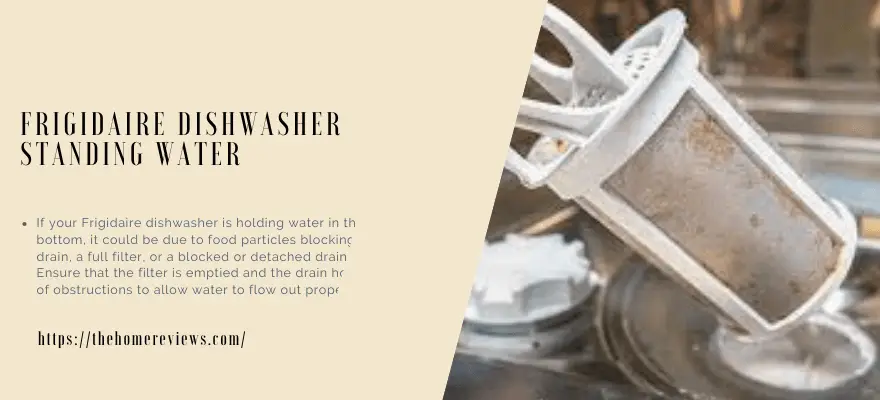
If your Frigidaire dishwasher is holding water in the bottom, it could be due to food particles blocking the drain, a full filter, or a blocked or detached drain hose. Ensure that the filter is emptied and the drain hose is free of obstructions to allow water to flow out properly.
Consider checking for any clogs in the drain line and removing them if necessary. Additionally, pressing and holding the cancel button on the control panel for at least three seconds can sometimes reactivate the drain mechanism. If these steps don’t resolve the issue, you may need to seek professional assistance or consider replacing the pump and motor assembly.
Reasons For Standing Water In Frigidaire Dishwasher
Having standing water in your Frigidaire dishwasher can be caused by a few things. It could be due to food particles blocking the drain, a full filter that needs to be emptied, or a blocked or broken drain hose. Make sure to check these areas for any issues and clean or repair them accordingly.
Frigidaire Dishwasher Standing Water
Is your Frigidaire dishwasher not draining properly? If you’re experiencing standing water in your dishwasher after a cycle, there could be a few reasons behind it. In this section, we will explore some common causes of standing water in a Frigidaire dishwasher.
Food particles blocking the drain:
- Food particles can accumulate in the drain and block the water flow.
- This can happen if dishes are not properly rinsed before loading them into the dishwasher.
- Over time, the food particles can create a clog and prevent the water from draining completely.
Full Filter Preventing Water Flow:
- Frigidaire dishwashers come equipped with a filter that helps prevent clogs in the drain.
- If the filter becomes full, it can impede the water flow and result in standing water.
- Cleaning the filter regularly is essential to ensuring proper drainage.
Blocked, Clogged, Broken, or Detached Drain Hose:
- Another reason for standing water in a Frigidaire dishwasher could be a blocked, clogged, broken, or detached drain hose.
- If the drain hose is blocked or clogged, the water cannot flow out properly.
- Likewise, if the drain hose is broken or detached, the water will not be able to exit the dishwasher effectively.
Taking care of these issues can help resolve the problem of standing water in your Frigidaire dishwasher. By ensuring your dishwasher is free of food particles, keeping the filter clean, and checking for any blockages or hose issues, you can help restore proper drainage.
Remember to always refer to the manufacturer’s manual or seek professional assistance if you are unsure about handling any repairs yourself.
Quick Fix Solutions For Frigidaire Dishwasher Standing Water
Is your Frigidaire dishwasher experiencing standing water? This could be caused by a dirty filter, a blocked drain hose, or food particles clogging the drain. Try cleaning the filter, checking the drain hose, and removing any blockages to fix the issue.
If you’re dealing with standing water in your Frigidaire dishwasher, don’t worry! There are quick-fix solutions that can help you resolve the issue and get your dishwasher back up and running. Below are some troubleshooting steps you can take to address the problem:
Cleaning the drain impeller:
- Remove the bottom dish rack to access the drain impeller.
- Inspect the drain impeller for any debris or clogs.
- Clean the impeller using a soft brush or toothbrush to remove any buildup.
- Ensure that the impeller can rotate freely.
Clearing the Circulation Impeller:
- Locate the circulation impeller, usually found beneath the spray arm.
- Check for any obstructions or blockages in the impeller.
- Gently clear away any debris that may be preventing the impeller from spinning properly.
- Ensure that the impeller is in good condition and able to rotate freely.
Checking the Air Gap:
- Locate the air gap, which is typically mounted on the countertop or sink.
- Remove the cover of the air gap and check for any blockages or clogs.
- Use a small brush or toothpick to clear away any debris that may be obstructing the airflow.
- Replace the cover and ensure that the air gap is securely in place.
Checking the Knockout Plug:
- Locate the knockout plug on the garbage disposal or sink drain.
- Remove the plug using pliers or a screwdriver.
- Check for any debris or blockages that may be preventing the water from draining properly.
- Clean the knockout plug and reinstall it securely.
Emptying the Glass Trap or Filter:
- Locate the glass trap or filter, usually at the bottom of the dishwasher.
- Remove the trap or filter and check for any food particles or debris.
- Dispose of the collected debris and rinse the trap or filter thoroughly.
- Reinstall the trap or filter securely in its place.
Siphoning Out Standing Water:
- Use a turkey baster or a wet vacuum to siphon out the standing water from the dishwasher.
- Carefully insert the baster or vacuum hose into the bottom of the dishwasher and remove the water.
- Repeat this process until the dishwasher is emptied.
Removing the Spinning Arm:
- Locate the spinning arm, usually at the bottom of the dishwasher.
- Twist or unscrew the arm to remove it from its position.
- Check for any obstructions or blockages in the arm or the spray holes.
- Clean the arm and spray holes with warm water and a mild detergent.
- Reinstall the spinning arm securely.
Removing the Large Circular Screen:
- Locate the large circular screen at the bottom of the dishwasher.
- Twist or unscrew the screen to remove it.
- Clean the screen thoroughly, removing any debris or buildup.
- Rinse the screen with warm water and reinstall it securely.
Running a Final Rinse Cycle:
- Load the dishwasher with dishes as usual.
- Add dishwasher detergent and select the appropriate wash cycle.
- Ensure that the dishwasher is properly closed and latched.
- Start the cycle and allow it to complete.
- Check if the standing water issue has been resolved.
By following these quick-fix solutions, you can address the problem of standing water in your Frigidaire dishwasher. Remember to always refer to your dishwasher’s user manual or consult a professional if you encounter any difficulties.
How To Prevent Frigidaire Dishwasher Standing Water
To prevent standing water in your Frigidaire dishwasher, make sure to check for clogs in the drain caused by food particles or a dirty filter. If the dishwasher isn’t draining properly, you can press and hold the cancel button on the control panel or manually drain it by turning off the power.
If the motor isn’t running or just humming, there may be a blockage in the drain line or an issue with the pump and motor assembly.
Regularly clean the filter to prevent clogs.
- Remove the filter according to the manufacturer’s instructions.
- Rinse the filter under running water to remove any debris.
- Inspect the filter for signs of damage or buildup, and clean it thoroughly if necessary.
- Make sure to re-install the filter properly before running the dishwasher.
Avoid using dish soap in the dishwasher.
- Dish soap creates excessive suds that can lead to standing water in the dishwasher.
- Only use dishwasher detergent specifically designed for automatic dishwashers.
- Dishwasher detergent is formulated to dissolve properly and prevent excessive sudsing.
Check the drain hose for blockages.
- Locate the drain hose at the back of the dishwasher.
- Disconnect the drain hose and inspect it for any blockages or kinks.
- Use a plumber’s snake or a straightened coat hanger to remove any clogs.
- Reconnect the drain hose securely after removing any blockages.
Ensure the garbage disposal is clear.
- If your dishwasher is connected to a garbage disposal, ensure that it is clear of any clogs.
- Run the garbage disposal and check for proper drainage.
- Clean the garbage disposal regularly to prevent any buildup that could cause standing water in the dishwasher.
Inspect the air gap.
- The air gap is a device located on the countertop or sink that prevents the backflow of water into the dishwasher.
- Remove the air gap cover and clean up any debris that may be blocking the flow of water.
- Ensure that the air gap hoses are properly connected and not kinked or damaged.
Run the garbage disposal before starting the dishwasher.
- If your dishwasher is connected to a garbage disposal, always run it before starting the dishwasher.
- This will help clear any food particles or debris in the drain line, preventing clogs and standing water.
Avoid overloading the dishwasher.
- Overloading the dishwasher can disrupt the water flow and lead to standing water.
- Follow the manufacturer’s guidelines for loading the dishwasher and ensure that dishes are properly spaced to allow water to circulate freely.
Scrape excess food off the dishes before loading.
- Remove excess food particles from dishes before loading them into the dishwasher.
- Large food particles can clog the dishwasher’s drain and cause standing water.
Check the dishwasher’s drain pump.
- If you’ve tried all the above steps and the dishwasher still has standing water, the drain pump may be faulty.
- Consult the manufacturer’s manual or contact a professional technician to inspect and replace the drain pump if necessary.
By following these preventive measures, you can avoid the frustrating issue of standing water in your Frigidaire dishwasher. Regular maintenance and proper usage will help keep your dishwasher running smoothly and efficiently.
Frequently Asked Questions
Why Is My Frigidaire Dishwasher Holding Water In The Bottom?
Possible Answer: The Frigidaire dishwasher may be holding water in the bottom due to food particles blocking the drain, a full filter, or a blocked, clogged, broken, or detached drain hose.
Why Does My Dishwasher Keep Having Standing Water?
The most common cause of standing water in your dishwasher is a dirty filter, which can get clogged with food particles. Make sure the drain hose is not blocked or detached. Try pressing and holding the cancel button to force the dishwasher to drain.
How Do I Force My Dishwasher to Drain?
To force your dishwasher to drain, follow these steps: 1. Press and hold the cancel button on the control panel for at least three seconds to reactivate the drain mechanism. 2. If that doesn’t work, turn off the power to the dishwasher and manually drain it by locating the outlet under your sink or in a cabinet next to the dishwasher.
3. Check for any blockages in the drain line and remove them if necessary. 4. Ensure that the garbage disposer’s drain plug has been removed if it was recently installed.
Why Is My Frigidaire Dishwasher Humming and Not Draining?
If your Frigidaire dishwasher is humming but not draining, it could be due to a blockage in the drain line or a faulty pump and motor assembly. Make sure to check for any clogs and remove the drain plug if a garbage disposal was recently installed.
Why Is My Frigidaire Dishwasher Holding Water In The Bottom?
Food particles might block your drain and prevent water from flowing out. Your filter is full. The drain hose is blocked, clogged, broken, or detached.
Conclusion
To fix the issue of standing water in your Frigidaire dishwasher, there are a few common problems you can check for. First, make sure that your drain isn’t blocked by food particles or other debris, as this can prevent water from flowing out.
Additionally, check and empty the filter to ensure it is not clogged. If the drain hose is blocked, clogged, broken, or detached, that could also be the culprit. It’s important to note that using dish soap in the dishwasher can cause overflowing, so avoid doing that.
Finally, if none of these solutions work, you can try pressing and holding the cancel button on the control panel for at least three seconds to reactivate the drain mechanism. If all else fails, you may need to manually drain the dishwasher or contact a professional for help.





